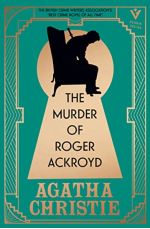It deserves all its accolades…
I feel a bit brash reviewing Agatha Christie’s The Murder of Roger Ackroyd. After all, it’s considered one of her masterpieces, and shows up on multiple “best mysteries” and “books to read before you die” lists. The acclaim is totally deserved, in my opinion, and I’m not quite sure what I can say about it that hasn’t already been said! Even so, I was happy to receive a review copy of a new e-book edition by Pushkin Vertigo, and so I’ll give it a try. Here we go…
On its face, the plot is pretty simple. Poirot has retired to the village of King’s Abbot, where one of his friends, the wealthy Roger Ackroyd (he of the title), lives. Poirot’s stated intention is to raise vegetable marrows, and he even goes as far as to accept the village’s anglicized version of his name, “Porrott,” in an attempt to go incognito. But of course, he eventually gets pulled back into things when Ackroyd is murdered less than a day after his lady companion, the widowed Mrs. Ferrars, dies.
Questions immediately arise. Were the rumors that Mrs. Ferrars poisoned her first husband actually true? And as a corollary – did Mrs. Ferrars take an accidental overdose of her sleeping medicine, or did she commit suicide? What is Ackroyd’s stepson doing in King’s Abbot, but not staying at Ackroyd’s mansion, Fernly Park? And are Ackroyd’s niece and stepson really in love, or just faking it for the money? In the absence of Captain Hastings, who is off in “the Argentine,” the tale is narrated by Poirot’s next-door neighbor and local doctor, James Sheppard. And it’s a classic whodunnit, with lots of suspects, hidden motives, clues, mysterious strangers, and dubious alibis – at least right up until the end, when Poirot’s little grey cells find the solution, and provide a not-at-all-classic twist that you won’t see coming.
One thing that I noticed in my (re)read of The Murder of Roger Ackroyd is more humor than I had remembered. The story is a bit somber, and these are not big guffaws, but little moments of amusement, as when Sheppard mentions, speaking of Mrs. Ferrars, that “lots of women buy their clothes in Paris, and have not, on that account, necessarily poisoned their husbands.” Christie had a sharp eye for human nature, and she deployed it throughout. Another thing I noticed was that, although The Murder of Roger Ackroyd has aged amazingly well, times have changed – or at least I hope they have. Without being too spoiler-ish, I really do hope that Mrs. Ferrars’ difficulties dealing with an abusive husband would have met with a different response now, in the 2020s, than in the 1920s, when the book was written. And finally, for inquiring minds that might wonder…per Wikipedia, a “vegetable marrow” seems to be something much like an American zucchini.
Wrapping up, though, with all levity aside, The Murder of Roger Ackroyd deserves its years of accolades. And if you haven’t read it, and you like murder mysteries at all, you should. Just do it! And my thanks again to Pushkin Vertigo for the review copy.
Buy (coming 25 October 2022): Amazon US | Amazon UK | Kobo US

